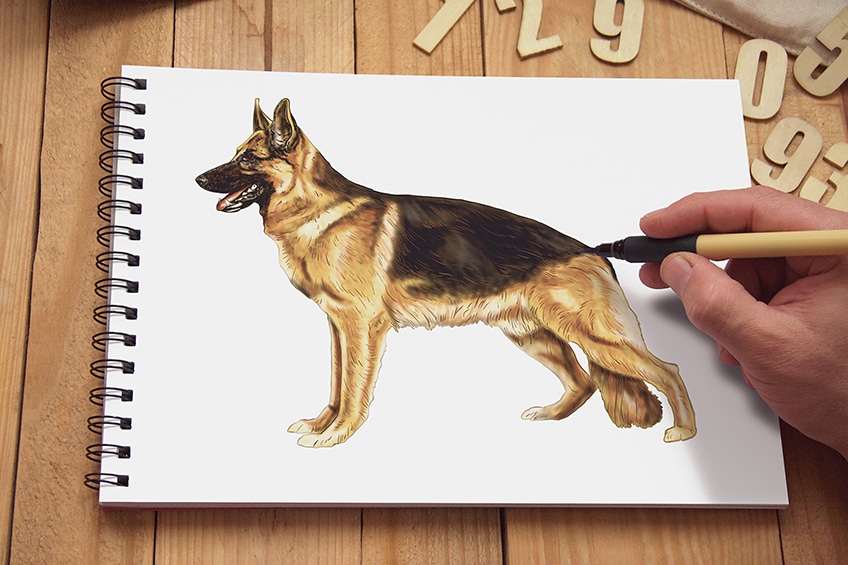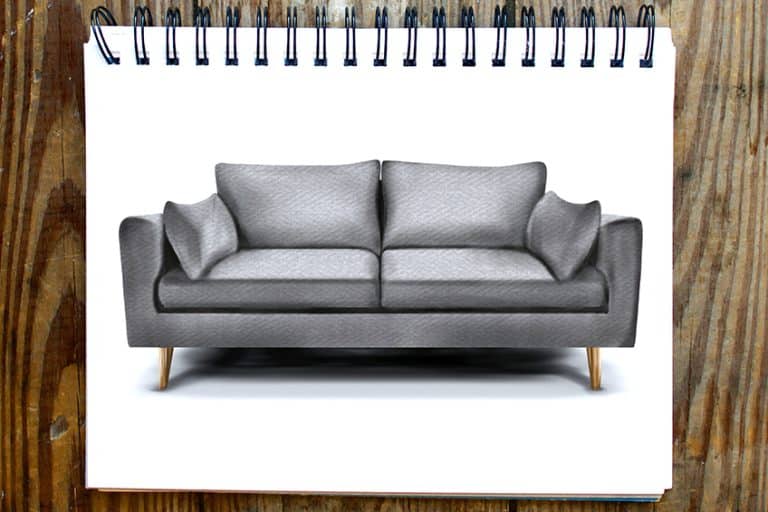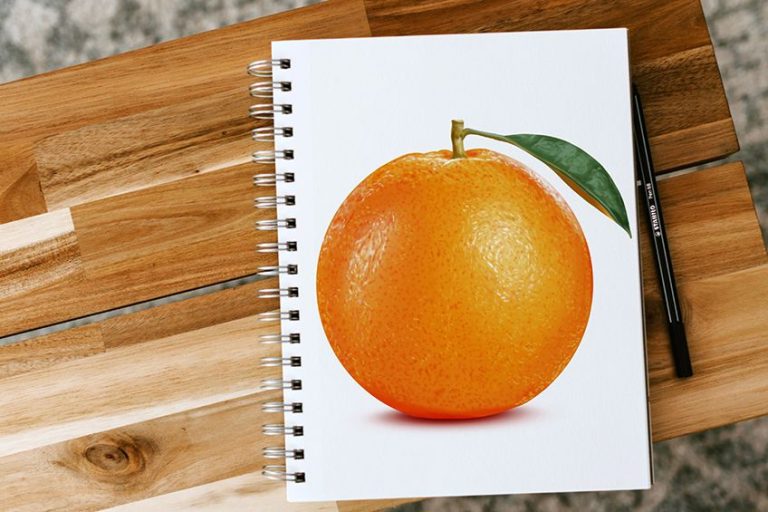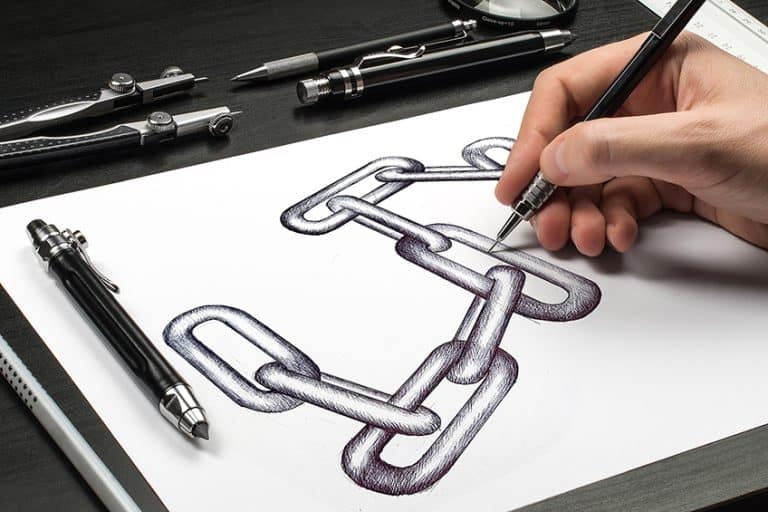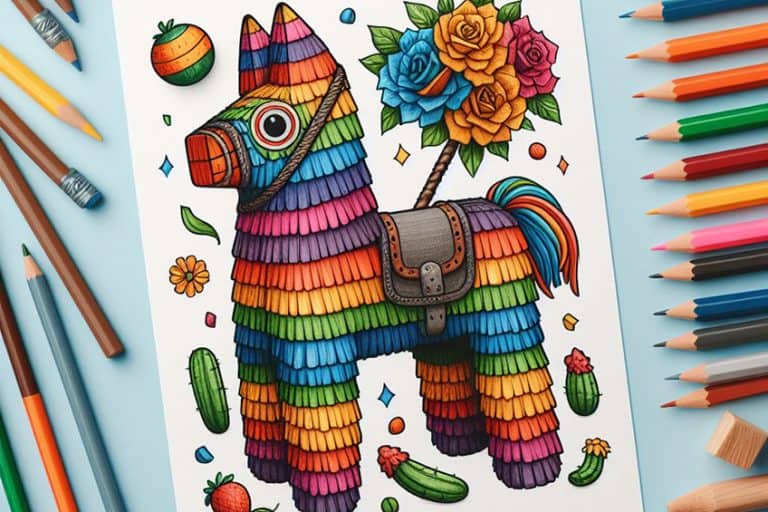How to Draw a German Shepherd – A Quick and Easy Drawing Tutorial
German shepherds are large and majestic dogs who make great companions. They also make great subjects for drawing studies. A german shepherd drawing is a fantastic way to practice many of the key skills in realistic animal drawing. In this realistic german shepherd drawing tutorial, we take you through all the steps necessary to capture the details and coloring in this beloved dog. Collect your drawing supplies, get comfortable, and let us begin!
German Shepherd Drawing Tutorial
The image below is the final german shepherd sketch that you will achieve by the end of this tutorial. German shepherds have quite a unique physiology, with their sloping back legs, large ears, and long muzzle. The coloring of a german shepherd is also unlike many other dogs. Nailing these physiological and color characteristics will guarantee you a realistic german shepherd drawing. Every artist has their own unique style, and this should always show through in your final product. As such, do not expect your german shepherd sketch to look exactly like ours.
You can use any medium of your choice to complete this tutorial. Whether you use a graphic tablet, or you prefer the allure of watercolor paint, you can simply adapt the instructions to suit your techniques.
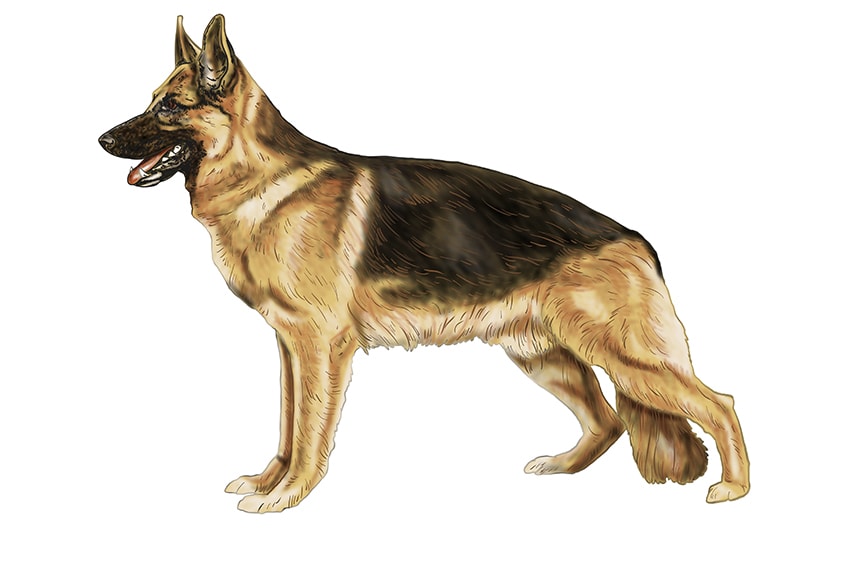
Step 1: Constructing the Main Body of Your German Shepherd Sketch
For all of our animal drawing tutorials, we always begin by using construction lines to lay down the basic shape and proportions of our animal. Beginning with the largest part of the german shepherd, we are going to use an elongated oval to represent the main body shape. In this very first step, you need to be aware of the final shape of your german shepherd sketch. The german shepherd is facing to the left of the canvas, and as a result, this side of the oval should be higher than the other. This slope will help you nail the sloping hips in your german shepherd drawing.
Our top drawing tip for this first step is to make sure that your main body construction oval is at the very center of your canvas. You will be adding legs and a head to this oval, so you need plenty of space!

Step 2: Constructing the Head of Your German Shepherd Sketch
This second step in our realistic german shepherd drawing tutorial is very simple. For the head, you can use a construction circle that is ever-so-slightly oval. Place this head circle just above the right end of the main body oval.
You can see on our example below that our circle is slightly oval and that it is angled downwards, with one end facing the bottom left of the canvas. This detail will help make the construction of the german shepherd’s face easier down the line.

Step 3: Constructing the Muzzle of Your German Shepherd Drawing
If you take another look at the finished drawing at the top of this tutorial, you will see that the mouth of the german shepherd is open slightly. In this step, we are going to use construction lines to lay the foundations for this muzzle. Begin by drawing a slightly uneven “U” shape that extends from the head circle down towards the left side of the canvas.
Beginning where this first upper “U” shape ends, draw another, smaller “U” shape to represent the bottom jaw of your german shepherd drawing.
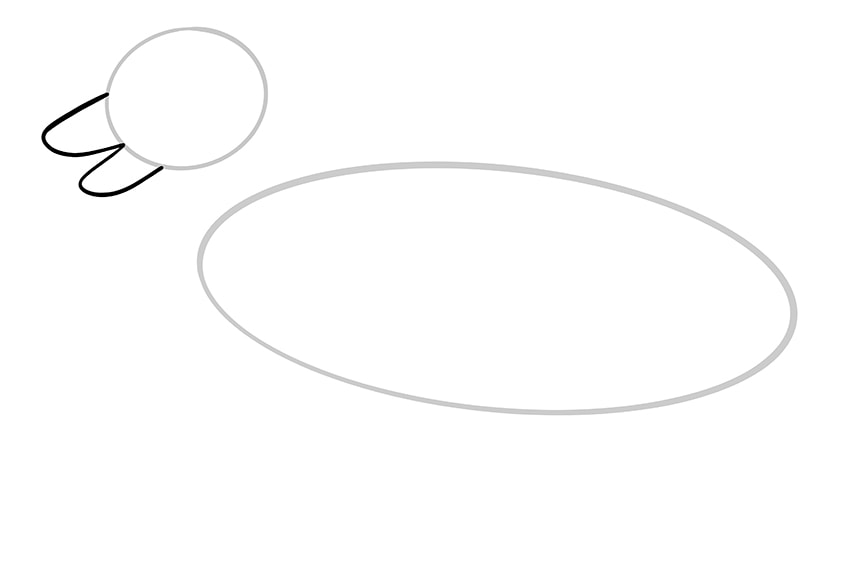
Step 4: Constructing the Ears of Your Dog
One of the most characteristic features of german shepherds is their large and upright ears. To create the basis for these ears, you can use a simple curved “M” shape on top of the head construction circle. Although drawing an “M” shape is fairly simple, you do need to pay attention to the perspective.
The ear towards the front of the head is further away from us, and it will therefore be slightly narrower than the back one because it appears smaller and because the base will be slightly hidden by the ear closest to us.

Step 5: Constructing the German Shepherd’s Front Legs
Because the german shepherd in our sketch is standing still, the two front legs are fairly straight and sit side-by-side. To capture the joint for this realistic german shepherd drawing, you are going to use a total of six lines for the leg closest to us, and four for the back one.
Once again, we need to remember to consider the perspective of our drawing in this step. The leg that is closest to the left side of the canvas is further away from us, and it is therefore slightly shorter and the majority of it is hidden by the leg closest to us.
Begin with the whole leg, which is the one that is closest to us. From about 1/5th of the way into the front of the body oval, draw a line that goes straight down. This line can be slightly angled, but not too much. Now, draw a smaller line that angles slightly towards the front of the german shepherd. To complete this leg, take another line down from the main body at more of an angle, and then draw a matching short line.
You can separate the top and bottom parts of the leg with a single line, and then draw an oval at the end of the leg to represent the foot.
For the second leg, simply draw the far-left line that curves slightly at the top as it leaves the main body oval. draw in the joint and foot construction lines in the same way as you did for the other leg.
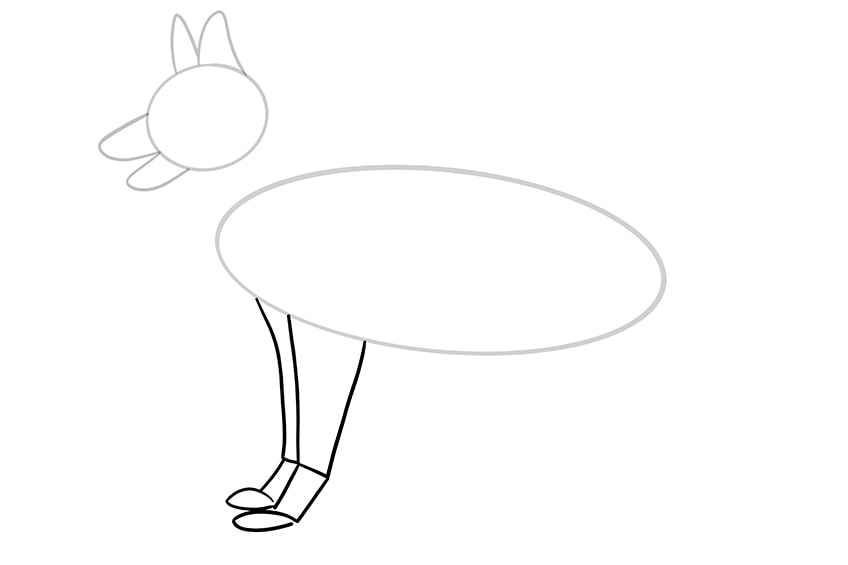
Step 6: Constructing the German Shepherd’s Back Legs
The process of this step is very similar to the previous one, except that the angles are more extreme and the lines can be slightly curved.
Start with the back leg that is further away from us, using a line that curves slightly towards the back of the canvas. Add the ankle joint using a short line that curves towards the front of the canvas, before finishing the leg with a longer foot oval, as this foot is side-on. Complete the back lines of this leg in the same way. For the very back leg, you can simply repeat these steps, making the leg thicker and more curved. The ankle joint can also be less curved towards the front of the canvas.
At the end of this step, you will see the german shepherd shape coming through quite clearly. In the next step, you are going to use this basic shape to create the final outline of your realistic german shepherd drawing.

Step 7: Drawing the Final Outline
In this step, you can use all the previously drawn construction lines to help you outline the final body of your german shepherd drawing. Begin with the head, using a curved line to hide the ear that is furthest out, and then outlining the ears with a more realistic shape. Add some inner curved lines to create the inner eardrum. Add the small eye detail on the side of the german shepherd’s face.
You can trace the muzzle construction lines quite closely and add a small nose patch. When you get to the bottom jaw, draw in the two large canine teeth, some back teeth, and the german shepherd’s tongue.
Add some bulges to the bottom neckline, and then take this line down to the legs and paws. You can trace the legs quite closely, but use some short strokes along the back of them to create the impression of fur. You can continue to use these short strokes to trace the belly of your german shepherd sketch into the first back leg. Use the same short fur strokes to outline the front of the very back thigh and adding in a fluffy tail between the back legs. Finish outlining the back legs in a single line and then take this line all the way up the back to join with the head.
When you are finished with this step and you are happy with your outline, you can erase any of the remaining construction lines.
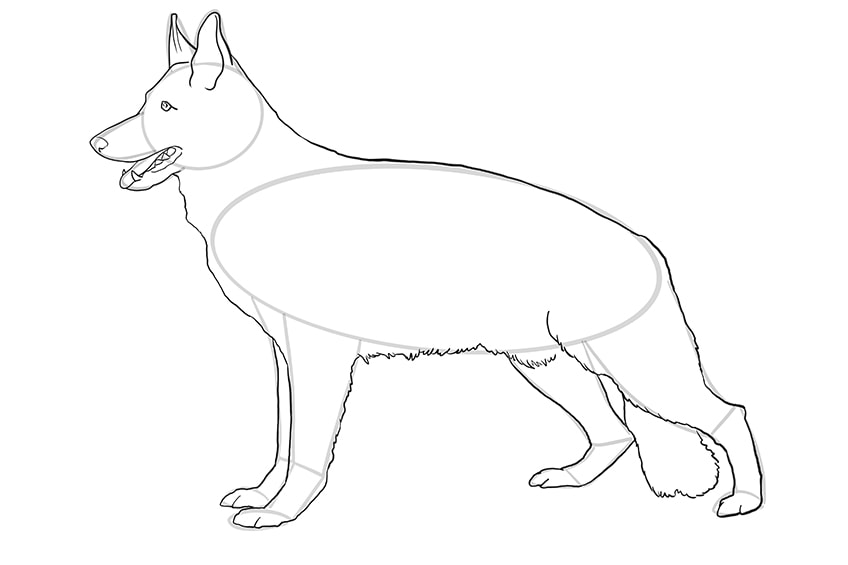
Step 8: Adding the Detailing and Fur
In this step, you are going to add fur detailing throughout the body of your german shepherd sketch. You are also going to add detailing to your german shepherd’s face.
Begin by adding some shading to the lower half of the german shepherd’s nostrils and below its jaw. Then, use some short strokes and dots to add some textural shading all around the german shepherd’s mouth and muzzle. You can also add some shading details to the teeth and the edge of the tongue. To create additional realism in the face of your german shepherd drawing, you can add some shading around the eyes and in the ear curves.
To draw the fur, it is important to consider the shape of your german shepherd. You want the hairlines to flow in the same direction as the body does. For example, the hair on the neck and back should flow downwards towards the back of the canvas. On the belly, tail, and back legs, you can direct the flow of the fur downwards.
For the most realistic german shepherd drawing, make sure that the hair lengths on the head are the shortest, and as you move down the body, they should get longer.
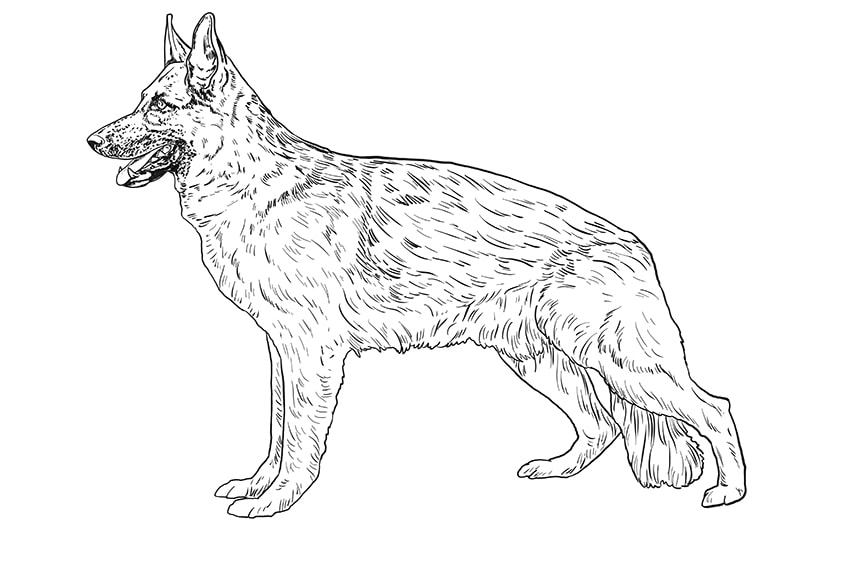
Step 9: Adding the First Coat of Color
To get a realistic coloring for your german shepherd drawing, you need to layer up a few different shades. We begin by adding a single light base color, and then we will add a second color coat and shading, and highlights to create depth and dimension.
For the base color of your realistic german shepherd drawing, choose a light shade of brown or caramel. You can use this shade to color the entire body of your german shepherd.

Step 10: Adding Shadows
For this step, choose a slightly darker and warmer shade of brown to add some shading to your german shepherd sketch. Use this coffee brown shade to create a patchy fur look around the top of the german shepherd’s hips, shoulders, ears, muzzle, belly, and on the underside of the legs.

Step 11: Adding Highlights
The highlight shade you want to use for this is a light beige color. Use a soft brush to apply this highlight around the top of the ears, just above the shoulder, along the back of the back leg, on the belly, and on the tops of the paws. You can also add a few patches of this highlight shade throughout the body.
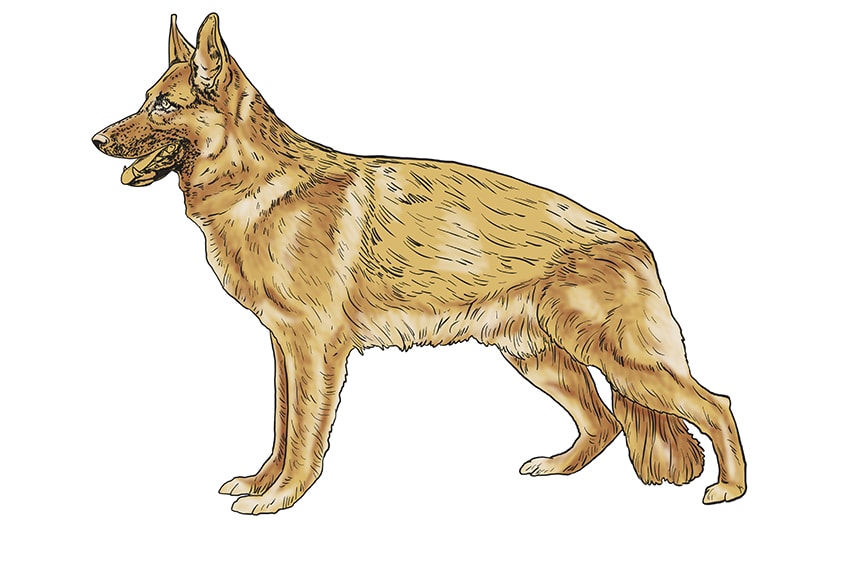
Step 12: Adding the Second Coat of Color
The second coat color you are going to use to create your realistic german shepherd drawing is black. Using a medium brush, add a coat of black paint around the german shepherd’s muzzle including the lower jaw. Color the nostrils with a lighter shade of grey, and use this same grey to add shading to the inside and outside of the ears, and around the eye.
Continue adding black along the back of the german shepherd’s spine, including the beck and back, and on the underside of the legs and tail.
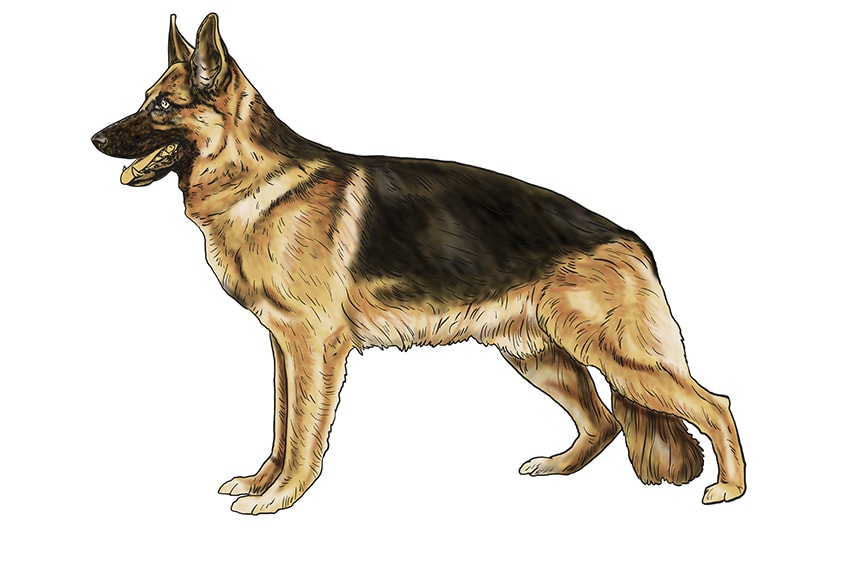
Step 13: Finalizing the Facial Details
For this final detailing step, you are going to need a shade of light red, white, and brown. Begin by coloring the tongue with a light shade of red and adding a small highlight to the side with a touch of white. Color all of the visible teeth with your white shade, and add a little dot to the eye.
Finally, for the last facial detail, use your shade of brown to color in the eyes of your german shepherd .
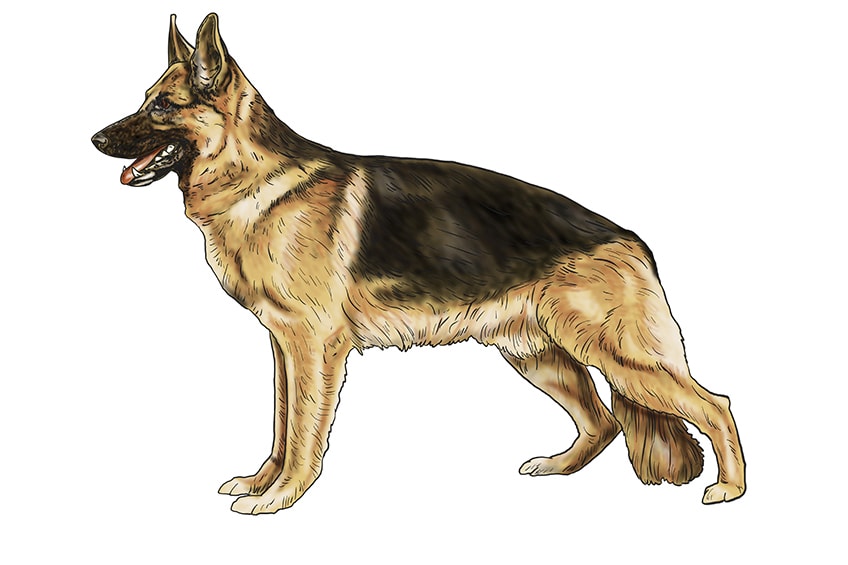
Step 14: Finishing Your Realistic German Shepherd Drawing
For this very final step, you can make your drawing even more realistic by removing the outline and tracing over your fur strokes with your paint. Use the color that corresponds to that particular part of your german shepherd, and cover any outlines or fine lines that disrupt the realism of your drawing.

Congratulations for finishing your realistic german shepherd drawing! We really hope that you have enjoyed the drawing process and that you are happy with your final sketch. Now that you know the basic process of how to draw a german shepherd, you can modify the tutorial to draw other types of dogs.
Frequently Asked Questions
What Is the Most Difficult Part of a German Shepherd Drawing?
On the whole, this german shepherd sketch tutorial is fairly straightforward. The most time-consuming and detail-oriented stage is the detailing of the face and fur throughout the body, but in this tutorial, we break the process down into very manageable steps.
Can These Instructions be Used to Draw Other Types of Dog?
Absolutely, you can certainly modify parts of this german shepherd drawing tutorial to help you draw other types of dogs. German shepherds do have a quite specific anatomy, in particular their sloping back hips, so you will have to be aware of and account for this in your modifications.
Matthew Matthysen is an educated multidisciplinary artist and illustrator. He successfully completed his art degree at the University of Witwatersrand in South Africa, majoring in art history and contemporary drawing. The focus of his thesis was to explore the philosophical implications of the macro and micro-universe on the human experience. Matthew uses diverse media, such as written and hands-on components, to explore various approaches that are on the border between philosophy and science.
Matthew organized various exhibitions before and during his years as a student and is still passionate about doing so today. He currently works as a freelance artist and writer in various fields. He also has a permanent position at a renowned online gallery (ArtGazette) where he produces various works on commission. As a freelance artist, he creates several series and successfully sells them to galleries and collectors. He loves to use his work and skills in various fields of interest.
Matthew has been creating drawing and painting tutorials since the relaunch in 2020. Through his involvement with artincontext.org, he has been able to deepen his knowledge of various painting mediums. For example, watercolor techniques, calligraphy and lately digital drawing, which is becoming more and more popular.
Learn more about Matthew Matthysen and the Art in Context Team.


